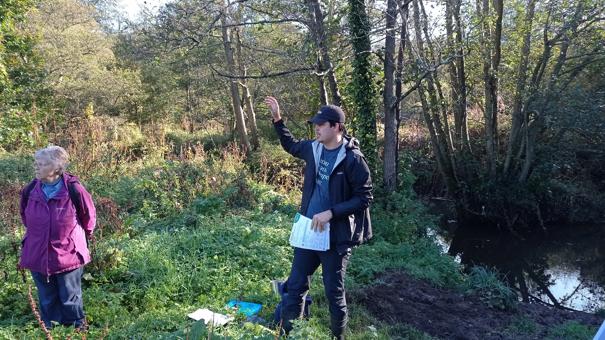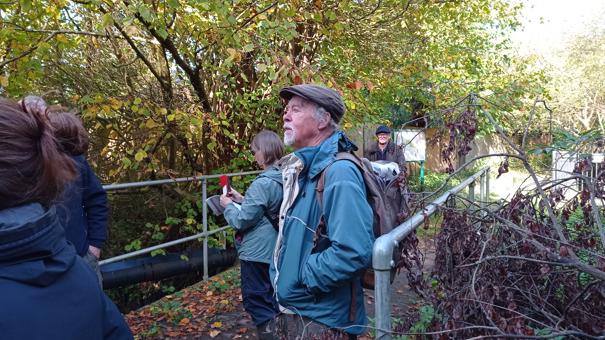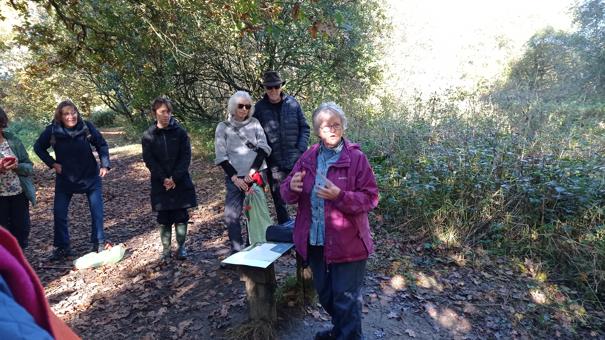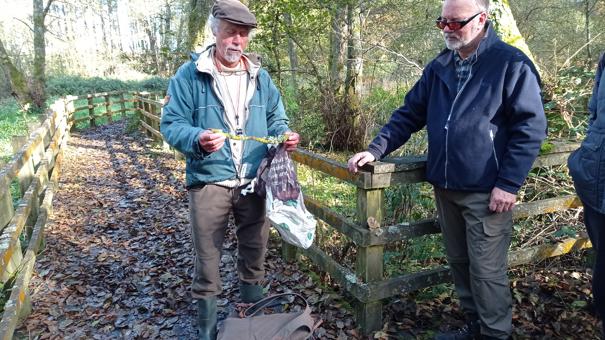On Sunday 27th October a group of 23 people gathered at the Penns Place car park to take a walk around the Rotherlands Nature Reserve, to find out about the health of the River Rother and the surrounding land and to get practical ideas about how we can preserve this natural environment. We were very pleased that the sun shone brightly, although the paths were very muddy.

Water quality monitoring
Keir Smith from Western Sussex Rivers Trust (WSRT) told us about the work of the trust in monitoring the health of the river. They have a scheme of volunteer river guardians who monitor the rivers and measure the temperature, nitrate and phosphate levels, turbidity, and the variety of wildlife seen around the river. This is displayed on a map on the website: https://wsrt.org.uk/get-involved/water-monitoring. We were pleased to hear that the water sample Keir took on Sunday was good.
Environment Agency Data on Untreated Sewage Discharges in 2023:
- Petersfield Treatment Works – 54 spills for a total of 543 hours. 6% of 2023
- Buriton– 172 Spills 2395 hours – 27% of 2023
- Lavant Treatment Works – 286 spills for a total of 6542 hours - 75% of 2023. Worst polluting treatment works in England.

Unblocktober
At the Pulens Lane pumping station Keir highlighted the issues caused by unwanted items being flushed down our drains and the problems these cause to the water treatment systems as well as to the environment around our rivers. 48% of the British public have flushed wet wipes, and 48% of the British public have poured fats, oils and grease down their drains. We learned about the Unblocktober campaign – “Our environment is changing for the worse, so now is the time to act! Unblocktober will help you make small changes to your habits and the way you dispose of certain everyday items, to make a big difference to the environment - as the impacts are being felt right here, right now.”
Keir told us about the app Yuka (https://yuka.io/en/) that you can use to scan food and beauty products to find out how kind they are to the environment. Where possible we should choose products that are eco-friendly and do not harm wildlife.
While on our walk we encountered several dog-walkers. Many of the dogs enjoy cooling off in the river. We spoke about the Flea-Mergency campaign to encourage pet owners to ensure their pets do not go into water if they have had a recent flea treatment, as the chemicals used can wash out of the fur and cause damage to the aquatic ecosystems. Further details here: https://theriverstrust.org/about-us/news/flea-mergency-pet-treatments-taking-a-bite-out-of-the-health-of-englands-rivers

Himalayan Balsam
Veronica Carter of Eco Rother Action (ERA) told us about the problem of a particularly pretty invasive species – Himalayan Balsam. This plant grows around many waterways, pushing out the native vegetation. The explosive seed pods can send seeds up to 7 metres from the original plant. We also discovered that the seeds have been observed to germinate in water. In order to control this plant, ERA run balsam-pulling events during the flowering season (June – August) with landowner permission. Check out the ERA website for dates and locations if you would like to be involved in these working groups: https://ecorotheraction.org/
Angela Ward from South Downs National Park Authority (SDNPA) spoke about the Park’s plans to eradicate Himalayan Balsam from the Rother catchment (the only river catchment which is wholly within the National Park), which is possible within 5 years.
Angela is looking for volunteers and community groups to come forward and, with support, adopt an area to manage. The project is using the INNS Mapper App (https://innsmapper.org/) (this can also be used on a desktop if you don’t have access to a smart phone) to monitor sightings of the plant, and where it has been pulled. Short and easy training videos can be found here: An Introduction to INNS Mapper - YouTube Care must be taken when pulling the plant – you should not pull it when it is in seed to avoid its spread. The stem should be broken into several pieces and the plant left in a pile on site (it is illegal to remove Himalayan Balsam from the location it is growing).’

Other Invasive Species
Himalayan Balsam is just one of the “Top 10 Most Wanted” invasive plants that SDNP want us to be aware of. The others are American Skunk Cabbage, Cotoneaster, Floating Pennywort, Giant Hogweed, Japanese Knotweed, New Zealand Pigmyweed, Parrot’s Feather, Rhododendron and Water Fern. There is a useful factsheet about these plants on the SDNP website: https://www.southdowns.gov.uk/custodians/farming/managing-invasive-non-native-species/
One of the other invasive species that SDNP is looking to eradicate is the mink population, which has decimated the native water vole population.
Angela talked briefly about the new Lottery funded project “Downs to the Sea” https://www.southdowns.gov.uk/downs-to-the-sea/ which will restore vital wetlands and ponds to good ecological condition, supporting biodiversity and reducing flood risk.

Lovely Lichens
Our final stop was at the pond on the reserve to admire some varied species of lichens. Peter Bisset from the Petersfield Area Lichen Enthusiasts (PALE) explained how these organisms are a complex a complex assemblage of fungal, algal, bacterial and yeast partners. The abundance and type of lichen can give a good indication of the amount and type of pollution in the area. Because lichens are slow-growing and long-lived they don't respond to individual weather events or even a few abnormal years so that changes in their distribution will reflect climate change. We found quite a variety of lichens and the species present indicated that the air quality is good in the reserve.
Quote from Keir Smith, Volunteer & Catchment Coordinator for the Western Sussex Rivers Trust:
"The Petersfield March for Clean Water was a fantastic local gathering of all those concerned and outraged about the state of our waterways. Together, we can resolve this public health emergency by demanding awareness and positive policy change in protecting our rivers for communities and wildlife. As WSRT's Chief Executive Aimee excellently puts, "We don’t need a few perfect environmentalists, we need a million imperfect ones". WSRT offer a variety of volunteering opportunities to monitor and improve our river health and local environment.
Thanks to PeCAN, all speakers and attendees for sharing the importance of water and how we can each do our bit to spread the word and champion our local waterways!"
We would like to thank Petersfield Town Council, who own and manage the Rotherlands Nature Reserve for allowing this walk to go ahead.
If you would like to volunteer to help maintain this wonderful nature reserve, please do get in touch and we will connect you with the appropriate people.



